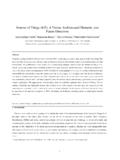Transcription of The Employment Effects of Advances in Internet and ...
1 The Employment Effects of Advances in Internet and Wireless Technology: Evaluating the Transitions from 2G to 3G and from 3G to 4G. Robert J. Shapiro and Kevin A. Hassett January 2012. 729 15th Street, NW 2nd Floor Washington, DC 20005 Tel: Paid for By NDN. EXECUTIVE SUMMARY. Continuing investments to upgrade the wireless broadband Internet infrastructure, including the transitions from 2G to 3G wireless technologies, and now from 3G to 4G, had produced cascades of innovation. Based on previous Advances , the current transition to 4G. technologies is likely to spur significant new job creation and growth which could help the American economy restore gains in incomes and business investment. New econometric analysis set forth in this study shows that the investments and innovation entailed in the transition from 2G to 3G wireless technologies and Internet infrastructure spurred the creation of some 1,585,000 new jobs from April 2007 to June 2011.
2 The investments being undertaken today to upgrade wireless network and Internet technologies from 3G to 4G hold comparable promise for job creation. This analysis estimates that under the current transition, every 10. percent increase in the adoption of 3G and 4G wireless technologies could add more than 231,000 new jobs to the economy in less than a year. Based on the substantial economic benefits arising from Advances in wireless broadband infrastructure and the adoption of devices that take advantage of that infrastructure, national policy should actively promote the rapid deployment and broad adoption of 4G wireless broadband. Wireless Advances Created Jobs Even in Recession Applying a unique database that provides detailed information on the ownership of mobile devices that operate on successive generations of wireless infrastructure, to state-by-state Employment data, the authors of the study show: The adoption of cell phones and other mobile devices supported by a shift from 2G to 3G.
3 Internet and wireless network technologies led to the creation of nearly million new jobs across the United States, between April 2007 and June 2011 even as total private sector Employment fell by nearly million positions. The rapid transition from 3G to 4G mobile broadband networks should continue to stimulate new job creation in a short time frame, generating more than 231,000 jobs for every 10 percentage point gain in penetration rates within a year. The research found that a 10 percentage point gain in penetration of a new generation of wireless technology in a given quarter leads to a percentage-point gain in Employment in the following quarter and continuing gains in subsequent quarters. These results suggest that a national job creation strategy should include or encourage appropriate measures to accelerate the deployment of 4G infrastructure.
4 4G Can Help American Meet Its National Broadband Goals In addition to jobs gains, which the authors verify with five additional statistical tests, widespread deployment of 4G technology could help the country achieve universal broadband service by ensuring that this service becomes quickly available to many rural Americans who 1. currently lack high-speed connectivity. 4G-enabled mobile services also could provide a less costly way for lower- and moderate-income Americans to access broadband. The advent of new generations of wireless technology will also enhance the overall benefits of Internet connectivity and related Advances in information and communications technologies (ICT). The McKinsey Global Institute, for example, has estimated that the Internet contributed about three percent to global GDP in 2009 and was responsible for 21 percent of GDP gains over the last five years.
5 This study also documents how the transition from 2G to 3G enabled or promoted the development of new products, services and industries. It further examines how the current, ongoing shift to 4G wireless infrastructure may open the door to a wide range of additional applications, services, products and new industries. These developments should generate or promote economic gains at least comparable to those produced by the build-out and adoption of 3G technologies. Investments in 4G mobile wireless technologies and infrastructure networks hold particular promise in areas such as online retail, health care, energy, and business services. Mobile e-commerce, for example, increased several-fold in recent years, growing from about $ billion in 2009 to between $6 billion and $9 billion in 2011 according to ABI.
6 Research. The shift to 4G can be expected to accelerate this growth. Savings from the wide use of electronic medical records created and accessed wirelessly, along with other mHealth apps, could total some $15 billion a year using current wireless technologies, and those savings would also grow as 4G apps become widely available and used. A national Smart Grid that applied wireless technologies to the nation's electricity networks could save $20 billion annually by simply reducing power outages, according to the National Energy Technology Laboratory. A 4G-based Smart Grid would save an additional $10 billion by further reducing the incidence of power failures. Cloud-based services, which are gaining rapidly in popularity, also would benefit from enhanced 4G wireless.
7 Juniper Research, for example, estimates that the market for mobile-based cloud services could reach $39 billion by 2016, assuming wide deployment of 4G infrastructure and devices. Policymakers Should Encourage Private Sector Investment in 4G Wireless Technologies The rapid deployment of 4G technologies and the innovations that will accompany them should generate significant and widespread societal gains, including a stronger economic recovery and expansion from the recent recession. Policies to promote the full deployment of 4G, therefore, should be part of any national job creation and economic strategy. 2. The Employment Effects of Advances in Internet and Wireless Infrastructure: Evaluating the Transitions from 2G to 3G and from 3G to 4G.
8 Robert J. Shapiro and Kevin A. Hassett I. Introduction Innovations do not occur on a predictable schedule. Nevertheless, there is strong evidence that the overall pace of innovation in information and communications technologies has accelerated in recent decades. Equally important, the rate at which businesses and households adopt these new technologies also have accelerated, including the changes, large and small, that firms and households have accepted to make effective use of these new technologies. It took more than 40 years for a majority of American businesses and households to adopt electrification. Nearly a century later, the current generation of American business and families adopted personal computers in about half of that time.
9 Similarly, mobile phone use, following a slow start, spread to a majority of households over a little more than a decade. The most recent innovations in this area have involved smart phones and upgrades in the Internet and wireless infrastructures on which smart phone applications depend. The shift from 2G to 3G. infrastructure occurred in 10 years, with 3G in place in 2005. Smart phones came on the market in 2005; and industry analysts expect that half of American households will own the devices by the end of 2011. The pace at which businesses and households adopt new technologies can have large economic consequences. Computers and the Internet are general purpose innovations which have been adapted successfully across every industry.
10 By enhancing efficiency, promoting innovation and generating significant additional growth across industries, they have had large and far-reaching economic Effects . Economists trace as much as three-fourths of productivity gains in the second half of the 1990s, for example, to the spread and effective use of information technologies. ICT (information and communication technology), including the Internet , has led directly to the creation of many thousands of new businesses, tens of thousands of new goods and services, and an untold number of new jobs. This study explores the economic Effects of an ICT innovation that has provided a platform for other innovations, the upgrading of the wireless infrastructure from 2G to 3G, the use of mobile devices that depend on 2G and 3G, and the potential impact of the current, on- going transition from 3G to 4G.







